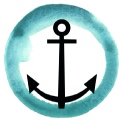



GROUP
Plymouth Field Course 2019
4
Disclaimer: the views and opinions on this website are not necessarily expressed by The National Oceanography Centre or the University of Southampton. They are completely representative of the authors of this website.

OFF-SHORE
Overview and Methodology:
The offshore survey was conducted on Saturday the 6th July 2019 from 7:45UTC to 16:55UTC. High tide was at 08:23UTC, and low tide occurred on the return at 14:30UTC. The sea state was very calm with minor swell towards E1. Weather conditions were stable throughout most of the day, with 40% cloud coverage, 7mph winds and air temperature of 20°C.
Four offshore stations were sampled from L4 to E1. At each station, a CTD profile was conducted to obtain nutrient, chlorophyll and oxygen saturation data. Niskin bottle samples were collected at the surface, in the water column and at depth based on the vertical profile of the water column. Due to a human error, only 1 bottle was fired at depth at Station 3. The bottle did not seal properly and the deepest bottle data was lost.
An ADCP was also used to conduct transects between stations and profiles at each station to visualize the structure of the water column and flow. Phytoplankton samples were taken at every station by treating seawater with formalin to preserve the specimens.
At 3 of the stations, a closing vertical zooplankton net with a specialised shutting system was used to sample the water column at specific depths corresponding to the thermocline or the deep chlorophyll maximum. The net was 53.2cm in diameter with a mesh size of 140µm. The samples were also treated with formalin to preserve them.
Meta Data:
Map of data stations:

L4 and E1:

At station 3, a deep chlorophyll maximum was observed. It was therefore decided by the PSO to take DAPI and Cytosense samples at all depths at this station. The DAPI samples were analysed using a fluorescent microscope to examine microbes in the samples; DNA in the DAPI was excited using UV light while chlorophyll was excited using green LED light. The cytosense samples were treated with glutaraldehyde fixer to preserve samples and processed in a flow cytometer to obtain cell counts of plankton per microliter of seawater.
At the final station we attempted to use the miniBAT, a CTD that undulates in the water over a long period to build an image of a cross section of the water. However, the miniBAT malfunctioned and was unable to complete dives rendering the data incomplete.
Click on map to enlarge
The data transects were made between station L4 (50 15.0’N; 4 13.0’W) and E1 (50 02 .6’ N; 4 22 .5’W), which are where the Autonomous Buoys are located. They hold clusters of sensors, providing data for the Western Channel Observatory (WCO) of the Western English Channel.
The E1 station has two systems which are supported by the Plymouth Marine Laboratory (PML) (hull, moorings and wave sensors) and the Met Office (in-water sensors). Both systems have an hourly data rate and report their data every hour [7].
The L4 Station also generates data every hour, but it only transmits its data every 3 hours to save power. In addition, the L4 Station is used for technological development, which it has been collaborating with companies to evaluate the suitability of their instruments at sea. Weekly in-situ measurements are made by research vessels of the PML at both stations [8].